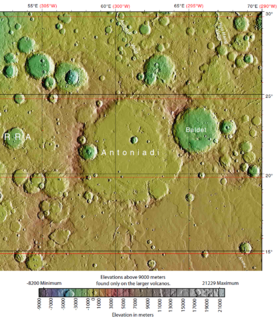
Boeddicker is a crater in the Aeolis quadrangle of Mars, located at 15° south latitude and 197.7° west longitude. It is 109 km in diameter and was named after Otto Boeddicker, a German astronomer (1853–1937).

Brashear Crater is an impact crater in the Thaumasia quadrangle of Mars, located at 54.14 S and 119.03 W. It is 77.45 km in diameter, and was named after John A. Brashear (1840–1920), an American astronomer. The name was approved in 1973.

Gasa is an impact rayed crater in the Eridania quadrangle on Mars at 35.68° S and 230.72° W. and is 6.5 km in diameter. Its name was approved in 2009, and it was named after a place in Bhutan. Gullies are evident in the images. It is now believed that the impact that created Gasa happened in a larger crater whose floor was covered with debris-covered glaciers. The larger crater is known as Cilaos, it is located at 35.71° S and 230.52° W. and is 21.4 km in diameter. Its name was approved on 15 August 2016, and it was named after a place in the island of Réunion.
Trumpler is a crater in the Phaethontis quadrangle of Mars, located at 61.8°S latitude and 150.8°W longitude. It measures approximately 78 kilometres (48 mi) in diameter and was named after Swiss-American astronomer Robert Julius Trumpler (1886–1956). The name was approved by IAU's Working Group for Planetary System Nomenclature in 1973.

Keeler is an impact crater on Mars, located at 61.0°S latitude and 151.3°W longitude in the Phaethontis quadrangle. It is 95.0 km in diameter and was named after James Edward Keeler, and the name was approved in 1973.

Liu Hsin Crater is a crater in the Phaethontis quadrangle of Mars, located at 53.6°S latitude and 171.6°W longitude. It is 137.0 km in diameter and was named after Liu Xin. Liu Hsin was a Chinese astronomer, historian, and editor during the Western Han Dynasty and the Xin Dynasty. The name was approved in 1973 by the International Astronomical Union (IAU) Working Group for Planetary System Nomenclature (WGPSN).

Haldane is an impact crater in the Eridania quadrangle of Mars, located at 52.8°S and 230.7°W. It is 77 km in diameter. It was named after British physiologist and geneticist J. B. S. Haldane; the name was approved in 1973 by the International Astronomical Union (IAU) Working Group for Planetary System Nomenclature (WGPSN).

Fontana is a crater in the Thaumasia quadrangle of Mars, located at 63.2°S latitude and 72.2°W longitude. It is 80.0 km in diameter and was named after Francesco Fontana, and the name was approved in 1973 by the International Astronomical Union (IAU) Working Group for Planetary System Nomenclature (WGPSN). The picture below shows dust devil tracks and dunes on the crater's floor.

Jarry-Desloges is an impact crater in the Iapygia quadrangle of Mars, located at 9.5°S latitude and 276.3°W longitude. It is 92.0 km in diameter and was named after René Jarry-Desloges, and the name was approved in 1973.

Baldet Crater is an impact crater in the Syrtis Major quadrangle of Mars, located at 23.0°N latitude and 294.6°W longitude. It is 180.0 km in diameter and was named after Fernand Baldet, and the name was approved in 1973 by the International Astronomical Union (IAU) Working Group for Planetary System Nomenclature (WGPSN).

Briault is an impact crater in the Mare Tyrrhenum quadrangle of Mars, located at 10.2°S latitude and 270.4°W longitude. It is 96.6 kilometers in diameter and was named after P. Briault, and the name was approved in 1973 by the International Astronomical Union (IAU) Working Group for Planetary System Nomenclature (WGPSN). The dark areas seen in the images are dunes; the curved dunes are called barchans.

Patera is an irregular crater, or a complex crater with scalloped edges on a celestial body. Paterae can have any origin, although majority of them were created by volcanism. The term comes from Latin language, where it refers to a shallow bowl used in antique culture.

Auki is an impact crater in the Mare Tyrrhenum quadrangle of Mars, at 15.76 °S latitude and 263.13 °W longitude. It is 40.0 km in diameter and was named after Auki, a town in the Solomon Islands, in 2015 by the International Astronomical Union (IAU) Working Group for Planetary System Nomenclature (WGPSN).

Ogygis Undae is the only named southern hemisphere dune field on Mars. It is named after one of the classical albedo features on Mars, Ogygis Regio. Its name, which refers to Ogyges, a primeval mythological ruler in ancient Greece, was officially approved by the International Astronomical Union (IAU) on September 17, 2015. It is situated just outside Argyre Planitia, a plain located in the southern highlands of Mars. The dunes of Ogygis Undae extend from latitude −49.94°N to −49.37°N and from longitude 292.64°E to 294.93°E. They are centered at latitude −49.66°N, longitude 293.79°E (66.21°W), and extend approximately 87 km to the east and west from there. Ogygis Undae has an area of 1904 km2, and due to its large size is a primary subject for research on Martian dune morphology and sand composition.

The Selk crater is a crater on Titan, a moon of Saturn, located at 7°N 199°W. It is a geologically young impact crater that measures approximately 90 kilometres (56 mi) in diameter.

















